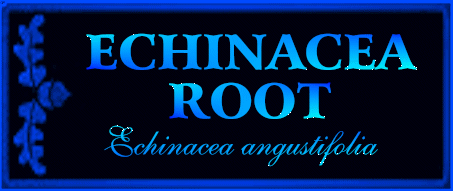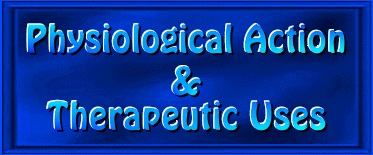

The following is excerpted from The Professional's Herbal Formula Handbook No. 2, comprising 82 pages of traditional information and recent scientific data that describes the medical properties, physiological action and therapeutic uses for each of the 24 ingredients outlined in this formula.




Adaptogenic, alterative, anabolic, antibiotic, anti-cachexic, anti-catarrhal, anti-dyscratic, anti-infective, antioxidant, antiphlogistic (anti-inflammatory), antiseptic, antineoplastic (anti-tumor), bacteriostatic (anti-bacterial), biocatalyst, cytophylactic, cytotoxic, deodorant, depurative, detoxicant, diaphoretic, disinfectant, diuretic, expectorant, fungistatic (anti-fungal), immuno-modulator, immuno-potentiating, immuno-stimulant, microbicidal (anti-microbial), parasiticide, stimulant (circulatory and secretolytic), tonic, tropho-restorative, vasodilator (peripheral) and viricidal (anti-viral).


Alleviates any general fluids dyscrasia (abnormal or pathological condition) within the blood vessels, tissue-systems and mucous membranes throughout the entire organism during the onset of any immuno-depressant or immuno-suppressant conditions, and eliminates any form of cachexia (state of malnourishment and general debility) within the blood vessels, tissue-systems or mucous membranes throughout the entire organism in order to provide increased protection against any nutritional deficiencies or insufficiency that leads to various forms of immuno-depression or immuno-suppression; acts as an extremely effective broad-spectrum natural antibiotic, due to the presence of echinacin; exhibits immuno-potentiating and immuno-stimulatory effects (due to the presence of the water-soluble polysaccharide echinacin B) in order to enhance greater long-term immune potential and overall non-specific systemic immunity (or immune cell activity) and increased immune response (by activating the body's natural defense mechanisms), particularly in relation to the repair and restoration of any damaged or congested blood vessels, tissue-systems or mucous membranes; displays antiphlogistic and viricidal activity (due to the presence of polysaccharides), and exhibits bacteriostatic (anti-bacterial), fungistatic (anti-fungal), and systemic microbicidal (anti-microbial) effects against Staphylococcus aureus, Streptococcus spp. and other hyaluronidase-secreting bacteria (due to the presence of fixed (caffeic acid glucoside) or volatile oils (polyacetylenes) and echinacoside glycosides); displays cytotoxic and cytophylactic properties in order to provide stronger cellular defense mechanisms against many physical or chemical agents and infectious conditions, including various brain, skin or intestinal infections; exhibits bacteriostatic, microbicidal and viricidal activity in order to strengthen and increase the resistance of the blood vessels against any invasive or harmful pathogenic bacteria or microbes, as well as to inhibit the further development of any inflammatory or infectious conditions associated with the onset of various auto-immune disorders; reduces the growth rate or reproductive capabilities of Trichomonas vaginalis or Candida albicans, and demonstrates anti-infective activity by inhibiting the secretion of the enzyme hyaluronidase in order to alter hyaluronic acid (which possesses cellular protective effects); acts as a profound non-specific immuno-stimulant and potentially useful immune system modulator to the immune defense system in diseases ranging from asthma to certain forms of cancer, and enhances the body's ability to become resistant to many viral or bacterial infections by stimulating the production and subsequent activity of several chemical mediators of immunity (immune mechanisms that are not controlled or mediated by antibodies) in order to increase resistance towards various infectious conditions; initiates antibody production in response to the presence of viruses, mold-like bacteria, yeasts, fungi, parasites, tumor-cells and various other microorganisms or invasive agents, and provides greater resistance to these pathogenic microbes and infective organisms by stimulating and strengthening the body's own defense mechanisms (or immune system) and eliminating poor immune response in order to ward off disease; prevents the spread of any harmful microorganisms by enhancing the body's ability to inhibit the secretion of hyaluronidase, which is secreted by various microbes for the purpose of increasing the permeability of the surrounding connective tissue (formerly referred to as the "spreading factor"); promotes the repair of any damaged connective tissue (collagen) by bonding with the enzyme hyaluronidase in order to inhibit its activity, and regenerates any cellular connective (granulomatous) tissue that was destroyed or damaged during certain infectious conditions in order to increase the integrity of the primary defense mechanisms against various pathogenic organisms; promotes less marked leukocytic infiltration into any damaged tissue, and possesses significant protective action towards any new tissue (muco-polysaccharides) being produced by the fibrocytes in the mesoderm layer of the skin (which is responsible for the manufacture of all types of connective tissue, bone marrow, blood and lymph); strengthens the natural immune defense mechanisms by releasing natural sources of insulin (inulin) and enhancing the production of the serum protein properdin (due to the presence of the muco-polysaccharides) in order to activate the alternative complement pathway, which increases non-specific host defense mechanisms such as the neutralization of viruses, the destruction of harmful pathogenic bacteria or microbes, and the increased migration of white blood cells (B-lymphocytes, neutrophils, basophils, eosinophils, monocytes, etc.) to specific areas of infection; accelerates the responsive capabilities of the white blood cells to attack and digest any harmful pathogenic bacteria, toxic immune-complex proteins, and the larger viruses associated with those conditions involving influenza, herpes, encephalomyocarditis, or vesicular stomatitis; activates significant and potent immuno-stimulatory effects or activity via the alternative complement pathway by utilizing specific types of polysaccharides that are able to adhere or bind themselves to certain carbohydrate receptor sites located on the cellular surface of the T-lymphocytes (or T-cells) and other white blood cells in various cellular membranes, resulting in non-specific T-cell activation (including the increased production and secretion of interferon and any other system-potentiating compounds), enhanced T-cell mitogenesis (reproduction), increased macrophage phagocytosis (general cellular immunity involving the scavenging, engulfment and destruction of harmful pathogenic bacteria or viruses by specialized cells), antibody binding, natural killer (NK) cell activity, and increased levels of circulating neutrophils (white blood cells that are primarily responsible for defending the organism against harmful invasive bacteria); increases T-cell transformation in order to enhance the cytotoxic destruction of virally-infected cells and the release of interferon (which blocks the replication of both DNA- and RNA-containing viruses or bacteria by binding itself to the cellular surfaces and stimulating the synthesis of proteins in the form of antibodies), thereby preventing the further invasion of pathogens or development of viral infections while stimulating the growth of fibroblasts (in order to increase the production of new tissue) by inhibiting intercellular diffusion and inflamed swelling (due to decreases in hyaluronic acid activity); displays significant antiphlogistic activity in order to inhibit the formation of certain inflammatory compounds (such as histamine, leukotrienes, prostaglandin, serine proteases and thromboxanes), as well as to reduce any severe inflammatory swelling associated with any blood vessel or tissue inflammation and various other internal inflammatory conditions; inhibits any inflammatory response through the use of anextremely complex water-soluble polysaccharide (echinacin B), thereby increasing the integrity of the connective "ground" substance (hyaluronic acid) in order for it to act as a barrier against the intrusion of pathogenic microorganisms into the bodily tissues; acts as a powerful tropho-restorative towards those mucous membranes that are irritated, inflamed or ulcerated, and produces a tightening or binding effect upon the mucous membranes and other exposed tissue in order to reduce any surface inflammation or irritation and act as a barrier against the further spread of infection; exhibits significant antiseptic activity by destroying the vitality of any organized living ferments in order to prevent the onset of putrefaction or septicemia, and precipitates the proteins in any inflamed tissues in order to provide a mildly antiseptic and protective coating (under which the regeneration of new tissue occurs) for the mucous membranes throughout the entire organism; acts as an effective antiseptic in order to remove any septic conditions associated with tissue degeneration or ulceration, and promotes increased suppuration and a steady toning or restorative impression to the entire glandular system (especially the liver and lymph glands); demonstrates anti-catarrhal and expectorant properties in order to accelerate and strengthen the functional capabilities of the entire expectoration process, thereby facilitating the loosening and expulsion of any excessive gummy or viscid mucoid or phlegmatic accumulations from the blood vessels, tissue-systems or mucous membranes throughout the entire organism; displays tumor-inhibiting effects (due to the presence of an oncolytic lipid-soluble hydrocarbon in the essential oil), as well as anti-tumor activity against certain forms of leukemia (due to the presence of a diene olefin in the volatile oils); demonstrates significant anti-cancer properties (due to the presence of the lipid-soluble compound (Z)-1,8-pentadecadiene), while displaying pronounced extracellular cytophylactic and cytotoxic activity against tumor target cells associated with carcinosarcoma and lymphocyte leukemia; prevents any further cancerous growth by stimulating the production of key lymphocytes (macrophages, etc.) which, in turn, trigger the activation of natural killer (NK) cells that destroy both cancer cells and invasive pathogenic agents; displays biocatalytic activity in order to enhance greater assimilation of those essential nutrients that are necessary for the increased production of energy and vitality, thereby accelerating certain rejuvenative processes associated with the repair of any damaged blood vessels, tissue-systems or mucous membranes; acts as a biocatalyst in order to accelerate and accentuate the transport of all the other herbal ingredients throughout the entire organism to specific areas of the body, and acts as a circulatory stimulant in order to permeate the entire organism (both internally and externally) with greater warmth and movement by supporting the innate warmth that resides in the blood; exhibits anabolic activity in order to accelerate the production of DNA and RNA (which enhances the production of proteins in the form of antibodies), while increasing protein and lipid synthesis in the bone marrow and DNA/RNA content in the adrenals and lymph nodes (along with increased body weight and enhanced re-synthesis of glycogen and high-energy phosphate compounds); demonstrates powerful adaptogenic (balancing and strengthening) activity in order to increase the overall resistance of an organism towards any adverse influences or stressful conditions (whether they be physical, chemical or biological in nature), especially upon the immune system and both the central (cerebro-spinal centers) and peripheral nervous systems; acts as a secretolytic stimulant in order to promote increased gastric, pancreatic or intestinal secretory and motor activity, and enhances greater peripheral circulation (due to its antioxidant activity); exhibits significant antioxidant effects in order to provide greater oxygen-transport capabilities throughout the bloodstream, as well as enhance the transport of additional oxygen directly into the cells and tissue-systems throughout the entire organism; acts as a circulatory stimulant by increasing the blood flows through the arteries and blood vessels in order to enhance greater nutrient transport, absorption and utilization, thereby accelerating the healing processes associated with the repair of any damaged blood vessels, tissue-systems or mucous membranes; displays alterative activity in order to correct any disordered bodily function, thereby activating increased alterations in both metabolic and tissue functions as a defensive measure against the onset of acute or chronic disease; exhibits restorative effects in order to regain increased vigor or vitality and greater strength, while enhancing normal tissue and metabolic functional capabilities; demonstrates alterative and restorative properties in order to re-establish healthy systemic functional capabilities, as well as to establish greater vascular tone throughout the entire organism (due to its ability to stimulate increased secretory flows); exhibits alterative effects in order to stimulate the anabolic growth processes, thereby enhancing the repair of any degenerated, deteriorated or debilitated cells or tissues (while promoting the elimination of any catabolic waste materials); displays tonifying effects in order to permanently enhance the overall energy-levels throughout the entire organism, without adversely affecting the functional capabilities of any particular organ or system.
![]()
None.
![]()